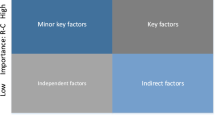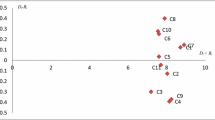Abstract
The Decision-making Trial and Evaluation Laboratory (DEMATEL) has widespread application in many fields as a system analysis method to explain the relationship between the risk factors in a system. By analyzing the influence relationship and degree of influence among risk factors, DEMATEL can determine their importance and priority. One characteristic of DEMATEL is that expert experience and knowledge should be fully considered. However, in practical applications, there are great uncertainties in the evaluation process because of the differences in experts’ historical experiences and subjective opinions. To address this issue, an improved fuzzy evidential DEMATEL method based on the two-dimensional correlation coefficient (2-DCC) and negation of basic probability assignment (BPA) is proposed in this paper. The new method uses 2-DCC to calculate the correlation between different expert evaluations in horizontal and vertical directions to get an overall correlation r and converts it into the macro-credibility and weight of experts. Then, to construct BPA according to the fuzzy evaluations, the total uncertainty (TU) measure and negation of BPA under the framework of evidence theory are used to deal with the uncertainty of evaluation, and then, the evaluations will be weighted and fused. Finally, the DEMATEL method is used to calculate the comprehensive influence matrix, and the importance of each risk factor is calculated. Two applications well verified the effectiveness of our method.







Similar content being viewed by others
Data availability
All data generated or analyzed during this study are included in the article.
References
Abeysekara B (2020) Application of fuzzy set theory to evaluate large scale transport infrastructure risk assessment and application of best practices for risk management. In: 2020 IEEE international conference on industrial engineering and engineering management (IEEM). IEEE, pp 385–389
Abraham Z, Venkatesh Venkataswamy G, Yang L, Wan Ming Q, Ting HD (2019) Barriers to smart waste management for a circular economy in china. J Clean Product 240:118198
Altuntas F, Gok MS (2021) The effect of COVID-19 pandemic on domestic tourism: A DEMATEL method analysis on quarantine decisions. Int J Hosp Manag 92:102719
Amirghodsi S, Naeini AB, Makui A (2020) An integrated Delphi-DEMATEL-ELECTRE method on gray numbers to rank technology providers. IEEE Trans Eng Manag
Asan U, Kadaifci C, Bozdag E, Soyer A, Serdarasan S (2018) A new approach to DEMATEL based on interval-valued hesitant fuzzy sets. Appl Soft Comput 66:34–49
Atanassov K (2016) Intuitionistic fuzzy sets. Int J Bioautom 20:1
Chauhan A, Jakhar SK, Chauhan C (2021) The interplay of circular economy with industry 4.0 enabled smart city drivers of healthcare waste disposal. J Clean Product 279:123854
Chen L, Li Z, Deng X (2020) Emergency alternative evaluation under group decision makers: a new method based on entropy weight and DEMATEL. Int J Syst Sci 51(3):570–583
Choirun A, Santoso I, Astuti R (2020) Sustainability risk management in the agri-food supply chain: literature review. In: IOP conference series: earth and environmental science, vol 475. IOP Publishing, p 012050
Chuanbo X, Yunna W, Dai S (2020) What are the critical barriers to the development of hydrogen refueling stations in china? A modified fuzzy DEMATEL approach. Energy Policy 142:111495
Das D, Datta A, Kumar P, Kazancoglu Y, Ram M (2022) Building supply chain resilience in the era of COVID-19: An AHP-DEMATEL approach. Oper Manag Res 15(1):249–267
Deng Y (2016) Deng entropy. Chaos Solit Fractals 91:549–553
Deng Y (2020) Uncertainty measure in evidence theory. Sci China Inf Sci 63(11):1–19
Dikbaş F (2017) A novel two-dimensional correlation coefficient for assessing associations in time series data. Int J Climatol 37(11):4065–4076
DİKBAŞ F, BACANLIÜG (2020) Detecting drought variability by using two-dimensional correlation analysis. Teknik Dergi 32(4):10947–10965
Dongdong W, Liu Z, Tang Y (2020) A new classification method based on the negation of a basic probability assignment in the evidence theory. Eng Appl Artif Intell 96:103985
Feng C, Ma R (2020) Identification of the factors that influence service innovation in manufacturing enterprises by using the fuzzy DEMATEL method. J Clean Product 253:120002
Gang K, Özlem OA, Hasan D, Serhat Y (2021) Fintech investments in European banks: a hybrid IT2 fuzzy multidimensional decision-making approach. Financ Innov 7(1):1–28
Gao X, Liu F, Pan L, Deng Y, Tsai S-B (2019) Uncertainty measure based on Tsallis entropy in evidence theory. Int J Intell Syst 34(11):3105–3120
Gao Y, Liang H, Sun B (2021) Dynamic network intelligent hybrid recommendation algorithm and its application in online shopping platform. J Intell Fuzzy Syst 40(5):9173–9185
George PG, Renjith VR (2021) Evolution of safety and security risk assessment methodologies towards the use of Bayesian networks in process industries. Process Saf Environ Protect 149:758–775
Han Y, Deng Y (2018) An enhanced fuzzy evidential DEMATEL method with its application to identify critical success factors. Soft Comput 22(15):5073–5090
Jiang S, Shi H, Lin W, Liu H-C (2020) A large group linguistic Z-DEMATEL approach for identifying key performance indicators in hospital performance management. Appl Soft Comput 86:105900
Jousselme A-L, Chunsheng L, Dominic G, Éloi B (2006) Measuring ambiguity in the evidence theory. IEEE Trans Syst Man Cybernet Part A Syst Humans 36(5):890–903
Kamble SS, Angappa G, Rohit S (2020) Modeling the blockchain enabled traceability in agriculture supply chain. Int J Inf Manag 52:101967
Kokangül A, Polat U, Dağsuyu C (2017) A new approximation for risk assessment using the AHP and fine Kinney methodologies. Saf Sci 91:24–32
Kouhizadeh M, Saberi S, Sarkis J (2021) Blockchain technology and the sustainable supply chain: theoretically exploring adoption barriers. Int J Product Econ 231:107831
Kumar PS, Priyabrata C, Abdul MM, Hung LK (2021) Supply chain recovery challenges in the wake of COVID-19 pandemic. J Bus Res 136:316–329
Li S, Wei C (2020) Hesitant fuzzy linguistic correlation coefficient and its applications in group decision making. Int J Fuzzy Syst 22(6):1748–1759
Li Y, Yong H, Zhang X, Deng Y, Mahadevan S (2014) An evidential DEMATEL method to identify critical success factors in emergency management. Appl Soft Comput 22:504–510
Li Z, Dongmei F, Li Y, Wang G, Meng J, Zhang D, Yang Z, Ding G, Zhao J (2019) Application of an electrical resistance sensor-based automated corrosion monitor in the study of atmospheric corrosion. Materials 12(7):1065
Lin S, Li C, Fangqiu X, Liu D, Liu J (2018) Risk identification and analysis for new energy power system in china based on d numbers and decision-making trial and evaluation laboratory (DEMATEL). J Clean Product 180:81–96
Mao H, Deng Y (2022) Negation of BPA: a belief interval approach and its application in medical pattern recognition. Appl Intell 52(4):4226–4243
Mohammed A, Naghshineh B, Spiegler V, Carvalho H (2021) Conceptualising a supply and demand resilience methodology: A hybrid DEMATEL-TOPSIS-possibilistic multi-objective optimization approach. Comput Ind Eng 160:107589
Ocampo L, Yamagishi K (2020) Modeling the lockdown relaxation protocols of the Philippine government in response to the COVID-19 pandemic: an intuitionistic fuzzy DEMATEL analysis. Socio-Econ Plann Sci 72:100911
Pal NR, Bezdek JC, Rohan H (1992) Uncertainty measures for evidential reasoning I: a review. Int J Approx Reason 7(3–4):165–183
Pal NR, Bezdek JC, Hemasinha R (1993) Uncertainty measures for evidential reasoning II: a new measure of total uncertainty. Int J Approx Reason 8(1):1–16
Pan Q, Zhou D, Tang Y, Li X, Huang J (2019) A novel belief entropy for measuring uncertainty in dempster-shafer evidence theory framework based on plausibility transformation and weighted hartley entropy. Entropy 21(2):163
Pandey M, Litoriya R, Pandey P (2019) Identifying causal relationships in mobile app issues: an interval type-2 fuzzy DEMATEL approach. Wirel Pers Commun 108(2):683–710
Raj A, Dwivedi G, Sharma A, de Sousa Jabbour ABL, Rajak S (2020) Barriers to the adoption of industry 4.0 technologies in the manufacturing sector: an inter-country comparative perspective. Int J Product Econ 224:107546
Shang X, Song M, Huang K, Jiang W (2020) An improved evidential DEMATEL identify critical success factors under uncertain environment. J Ambient Intell Humaniz Comput 11(9):3659–3669
Tang Y, Chen Y, Zhou D (2022) Measuring uncertainty in the negation evidence for multi-source information fusion. Entropy 24(11):1596
Tang Y, Tan S, Zhou D (2023) An improved failure mode and effects analysis method using belief Jensen–Shannon divergence and entropy measure in the evidence theory. Arab J Sci Eng 48:7163–7176
Tanvir AS, Sayem A, Mithun AS, Sudipa S, Golam K et al (2021) Challenges to COVID-19 vaccine supply chain: implications for sustainable development goals. Int J Product Econ 239:108193
Tavares BG, da Silva CES, de Souza AD (2019) Risk management analysis in scrum software projects. Int Trans Oper Res 26(5):1884–1905
Trivedi A (2018) A multi-criteria decision approach based on DEMATEL to assess determinants of shelter site selection in disaster response. Int J Disaster Risk Reduct 31:722–728
Wang X, Song Y (2018) Uncertainty measure in evidence theory with its applications. Appl Intell 48(7):1672–1688
Yadav S, Singh SP (2020) Blockchain critical success factors for sustainable supply chain. Resour Conserv Recycl 152:104505
Yager RR (2014) On the maximum entropy negation of a probability distribution. IEEE Trans Fuzzy Syst 23(5):1899–1902
Yasar M, Dikbas F (2022) Multivariate outlier detection in a precipitation series using two-dimensional correlation. Fresenius Environ Bull 31(3):2451–2465
Yazdi M, Kabir S, Walker M (2019) Uncertainty handling in fault tree based risk assessment: state of the art and future perspectives. Process Saf Environ Protect 131:89–104
Yazdi M, Khan F, Abbassi R, Rusli R (2020) Improved DEMATEL methodology for effective safety management decision-making. Saf Sci 127:104705
Yin L, Deng X, Deng Y (2018) The negation of a basic probability assignment. IEEE Trans Fuzzy Syst 27(1):135–143
Yuan-Wei D, Zhou W (2019) New improved DEMATEL method based on both subjective experience and objective data. Eng Appl Artif Intell 83:57–71
Zeshui X (2007) Intuitionistic fuzzy aggregation operators. IEEE Trans Fuzzy Syst 15(6):1179–1187
Zhang R, Ashuri B, Deng Y (2017) A novel method for forecasting time series based on fuzzy logic and visibility graph. Adv Data Anal Classif 11(4):759–783
Zhang Q, Li M, Deng Y (2018) Measure the structure similarity of nodes in complex networks based on relative entropy. Physica A: Stat Mech Appl 491:749–763
Zhang C, Tian G, Fathollahi-Fard AM, Wang W, Wu P, Li Z (2020) Interval-valued intuitionistic uncertain linguistic cloud petri net and its application to risk assessment for subway fire accident. IEEE Trans Autom Sci Eng
Zheng Q, Shen S-L, Zhou A, Lyu H-M (2022) Inundation risk assessment based on G-DEMATEL-AHP and its application to Zhengzhou flooding disaster. Sustain Cities Soc 86:104138
Zhongyi W, Liu W, Nie W (2021) Literature review and prospect of the development and application of FMEA in manufacturing industry. Int J Adv Manuf Technol 112(5):1409–1436
Zhou X, Shi Y, Deng X, Deng Y (2017) D-DEMATEL: a new method to identify critical success factors in emergency management. Saf Sci 91:93–104
Funding
The work was supported by the Natural Science Basic Research Program of Shaanxi (Program No. 2023-JC-QN-0689) and NWPU Research Fund for Young Scholars (Grant No. G2022WD01010).
Author information
Authors and Affiliations
Corresponding author
Ethics declarations
Conflict of interest
The authors declare no conflict of interest.
Additional information
Publisher's Note
Springer Nature remains neutral with regard to jurisdictional claims in published maps and institutional affiliations.
Rights and permissions
Springer Nature or its licensor (e.g. a society or other partner) holds exclusive rights to this article under a publishing agreement with the author(s) or other rightsholder(s); author self-archiving of the accepted manuscript version of this article is solely governed by the terms of such publishing agreement and applicable law.
About this article
Cite this article
Liu, Y., Tang, Y., Yang, Z. et al. Improved fuzzy evidential DEMATEL method based on two-dimensional correlation coefficient and negation evidence. Soft Comput 27, 11177–11192 (2023). https://doi.org/10.1007/s00500-023-08748-y
Accepted:
Published:
Issue Date:
DOI: https://doi.org/10.1007/s00500-023-08748-y




